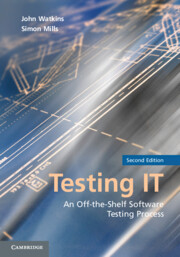Book contents
- Frontmatter
- Contents
- Foreword to the Second Edition by Geoff Thompson
- Foreword to the First Edition by Maurice Rosenburgh
- Acknowledgments
- 1 Introduction
- PART 1 THE TRADITIONAL TESTING PROCESS
- 2 An Overview of Testing
- 3 Testing Techniques
- 4 The Management and Planning of Testing
- 5 Unit Testing
- 6 Integration Testing
- 7 System Testing
- 8 Systems Integration Testing
- 9 User Acceptance Testing
- 10 Operations Acceptance Testing
- 11 Regression Testing
- 12 Improving the Testing Process
- 13 Introduction, Adoption, and Maintenance of the Testing Process
- 14 Agile Testing
- PART 2 THE TESTING PROCESS IN THE REAL WORLD: ILLUSTRATIVE CASE STUDIES
- PART 3 THE APPENDICES
- References
- Glossary
- Index
6 - Integration Testing
Published online by Cambridge University Press: 03 May 2011
- Frontmatter
- Contents
- Foreword to the Second Edition by Geoff Thompson
- Foreword to the First Edition by Maurice Rosenburgh
- Acknowledgments
- 1 Introduction
- PART 1 THE TRADITIONAL TESTING PROCESS
- 2 An Overview of Testing
- 3 Testing Techniques
- 4 The Management and Planning of Testing
- 5 Unit Testing
- 6 Integration Testing
- 7 System Testing
- 8 Systems Integration Testing
- 9 User Acceptance Testing
- 10 Operations Acceptance Testing
- 11 Regression Testing
- 12 Improving the Testing Process
- 13 Introduction, Adoption, and Maintenance of the Testing Process
- 14 Agile Testing
- PART 2 THE TESTING PROCESS IN THE REAL WORLD: ILLUSTRATIVE CASE STUDIES
- PART 3 THE APPENDICES
- References
- Glossary
- Index
Summary
“Computers are like Old Testament gods; lots of rules and no mercy.”
– Joseph CampbellOverview
The objective of integration testing is to demonstrate that modules comprising the application under test (AUT) interface and interact together in a correct, stable, and coherent manner prior to system testing. Integration testing is typically conducted by the development team and involves independent observation of the testing process. Integration testing may also be termed link or module testing, but it should not be confused with systems integration testing (see Chapter 8).
Testing should be performed against the functional requirements of the AUT using black box testing techniques. Test case design should demonstrate correct interfacing and interaction between modules but should avoid duplication of unit testing effort (however, where appropriate, reuse of unit tests should be considered to reduce testing timescales and effort).
The precise definition of a “module” depends on the approach to design of the AUT and the implementation technology. For example:
A module in an application developed using a procedural programming language could be represented by a closely related group of functions or procedures that perform a well-defined service within the AUT and that communicate with other component modules via strictly defined interfaces
A module in an application developed using an object-oriented programming language could be represented by a collection of objects that perform a well-defined service within the AUT and that communicate with other component modules via strictly defined interfaces
[…]
- Type
- Chapter
- Information
- Testing ITAn Off-the-Shelf Software Testing Process, pp. 56 - 62Publisher: Cambridge University PressPrint publication year: 2010



